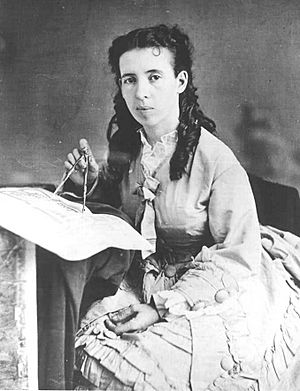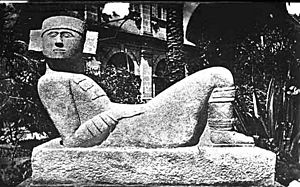Augustus Le Plongeon facts for kids
Quick facts for kids
Augustus Le Plongeon
|
|
|---|---|

Photograph by Alice Dixon Le Plongeon
|
|
| Born | 4 May 1825 Island of Jersey |
| Died | 13 December 1908 (aged 83) Brooklyn, New York, U.S. |
| Occupation | Antiquarian and amateur archaeologist |
| Nationality | British-American |
| Subject | Maya civilization, Atlantis |
| Spouse | Alice Dixon Le Plongeon |
Augustus Henry Julian Le Plongeon (born May 4, 1825 – died December 13, 1908) was a British-American archaeologist and photographer. He spent many years studying the ancient ruins in the Americas. He was especially interested in the Maya civilization in the northern Yucatán Peninsula of Mexico.
Augustus Le Plongeon had many ideas that were not accepted by other experts at the time. Some of his theories were later proven wrong. However, he is still remembered for his amazing photographs. He took many pictures that show what the ancient ruins looked like. He was also one of the first people to support the idea of Mayanism, which is the study of the Maya.
Contents
Early Life and Adventures
Augustus Le Plongeon was born on the Island of Jersey on May 4, 1825. When he was 19, he sailed to South America. His ship crashed near the coast of Chile. He decided to stay in Valparaiso, Chile. There, he taught math, drawing, and languages at a local college.
In 1849, he traveled to San Francisco during the California gold rush. He worked as a surveyor, which means he measured and mapped land. He also trained to become a doctor. One of his jobs was drawing the layout for the town of Marysville, California in 1851. Augustus was paid with land for his surveying work. He sold this land and used the money to pay for most of his archaeology trips.
Le Plongeon later went to England. He saw new ways to take photos at The Great Exhibition. He stayed in England to learn photography from William Fox Talbot. Augustus wanted to try these new methods in warm places. So, he traveled to St. Thomas, Mexico, Australia, China, and the Pacific Islands. He then returned to San Francisco. There, he opened a studio where he took special photos called daguerreotype portraits. In 1862, he moved to Lima, Peru. He opened another photography studio and a health clinic that used water treatments.
Exploring Peru
Augustus Le Plongeon was one of the first people to use photography for his studies. He used the same method he used for portraits to record his explorations. He traveled all over Peru for eight years. He visited and photographed many ancient ruins, including Tiahuanaco. Augustus also joined some trips led by E. G. Squier. He took photos of the sites they explored.
Le Plongeon was inspired by other explorers like Charles Étienne Brasseur de Bourbourg, John Lloyd Stephens, and Frederick Catherwood. His own trips in Peru, combined with their work, made him believe something unique. He thought that human civilization first started in the Americas.
While in Peru, Augustus became very interested in why earthquakes happen. He saw the big 1868 Arica earthquake. He studied the damage and talked to people about what they experienced. During this time, Le Plongeon also spoke out against some actions of the Catholic Church in Peru. He wrote two books about his views.
In 1870, he left Peru and went back to San Francisco. He gave talks with pictures at the California Academy of Sciences. These talks were about Peruvian archaeology and earthquakes. He then traveled to New York. By 1871, he was at the British Museum in London. He was studying old books and writings from ancient Central America.
Alice Dixon Le Plongeon

While in London, Augustus met Alice Dixon. She would work with him for the rest of his life. Alice was born in London in 1851. Her father, Henry Dixon, was famous for helping to develop panchromatic photography. He also took photos of London buildings. Alice learned photography from her father and worked in his studio.
After meeting Augustus, Alice became interested in ancient American civilizations. She read a book about travel in Yucatan by John L. Stephen. She agreed to go with Augustus on an archaeology trip to study Maya ruins in Mexico. The two went to New York to get ready for the trip. They got married in New York before traveling to Mexico in 1873.
Travels in Yucatán
In 1873, the Le Plongeons traveled to Yucatán, Mexico. They wanted to study ancient Maya sites. Their goal was to see if there were links between the Maya and ancient Egypt or the lost city of Atlantis. Their first stop was in Mérida. They stayed there while Alice recovered from yellow fever. During this time, they met local experts. Both Augustus and Alice learned to speak the Yucatec Maya language. After Alice felt better, they took a short trip to Uxmal.
The Le Plongeons were in Yucatán during the Caste War. This was a fight between the Maya people and the army of Yucatán. When they traveled to Chichen Itza in 1875, soldiers went with them for protection. When they arrived, local Maya men were hired to clear plants and help with digging.
The Le Plongeons were among the first people to photograph and study Chichen Itza. They took hundreds of 3-D photos in a very careful way. They photographed entire Maya buildings, like the "Governor's Palace" at Uxmal. They used a tall tripod or scaffold to get the best angles. They even developed their photos in the dark rooms of Maya buildings.
Besides whole buildings, they also photographed small artifacts. They took pictures of details like bas-reliefs (carvings that stick out from a surface), Maya hieroglyphic writing, and sculptures. They dug up buildings, drew maps, copied murals (wall paintings), and made molds of the carvings.
At Chichen Itza, they dug up a structure called the Platform of the Eagles and Jaguars. They found a large statue or altar figure. They called it "Chaacmol" (which later became "Chac Mool" or chacmool). Even though their name for it was not linked to the statue's true meaning, the name is still used by archaeologists today. This statue later showed that the Toltec people had influenced the site. Other similar statues were found at the Toltec capital, Tula. They also took photos and made drawings of their dig at the Platform of Venus.
From 1873 to 1884, the Le Plongeons visited and photographed other Maya sites. These included Izamal, Isla Mujeres, Cozumel, Cancún, and Ake. They also traveled to Belize. During this time, they made a few trips back to New York. They tried to sell their molds of carvings to museums. They also gave talks and looked for money to support their studies.
Interesting Theories
By the 1880s, most experts believed that the Maya civilization came after Ancient Egypt. But Le Plongeon stuck to his own ideas. He said his years of fieldwork and studies of old records proved him right. He challenged other archaeologists to debate him. However, as more evidence showed that cultures did not just spread from one place, Le Plongeon's ideas became less popular. His theories moved further away from what most Maya archaeologists believed.
Le Plongeon believed that the symbols of Freemasonry came from the ancient Maya. He also thought that ancient knowledge traveled from the Maya to ancient Egypt through Atlantis. He and Alice created a very imaginative "history." They believed that the Maya sites in Yucatán were where civilization first began. Then, civilization traveled east, first to Atlantis and later to Ancient Egypt. The Le Plongeons even named kings and queens from these ancient times. They said that various artworks were portraits of these old royals. For example, they believed the famous Chacmool statue they found was a portrait of Prince Coh. The Le Plongeons made up a detailed story about Queen Moo and Prince Coh (also called "Chac Mool"). In their story, Prince Coh's death led to monuments being built in his honor.
Books Written
- Vestiges of the Mayas (New York, 1881)
- Sacred Mysteries Among the Mayas and the Quiches, 11,500 Years Ago (New York, 1886)
Later Life and What He Left Behind
Most of Le Plongeon's ideas were not accepted by other experts. However, some people, like Ignatius L. Donnelly and Helena Blavatsky, used his research for their own theories. Augustus spent the rest of his life in Brooklyn, New York. He continued to write about the links between the Maya and Egypt. He also defended his ideas against those who disagreed with him. Augustus Le Plongeon died in Brooklyn in 1908 when he was 83 years old. Alice died in 1910 at age 59.
A collection of the Le Plongeons' work is now kept at the Getty Research Institute in Los Angeles. This collection includes their diaries, notes, letters, and many photographs. These records cover their travels from the 1860s to the early 1900s. They show ancient buildings, sculptures, city views, and studies of different cultures.
Le Plongeon was chosen as a member of the American Antiquarian Society in 1878.
Images for kids
See also
 In Spanish: Augustus Le Plongeon para niños
In Spanish: Augustus Le Plongeon para niños





